Features
Priced at just £150/€185/$200 including delivery directly from Classic Audio Ltd., the SPARTAN 5 is intended as an upgrade over integrated and low-cost external phonostages alike. It is an original design that obtains stronger RIAA accuracy, a second order subsonic filter, a mono switch, and a split linear power supply from a single-stage phono preamplifier. With a very low power consumption that makes power switching and startup circuitry redundant, it is not only high-efficiency in terms of power, but also in features, cost, and most importantly performance.
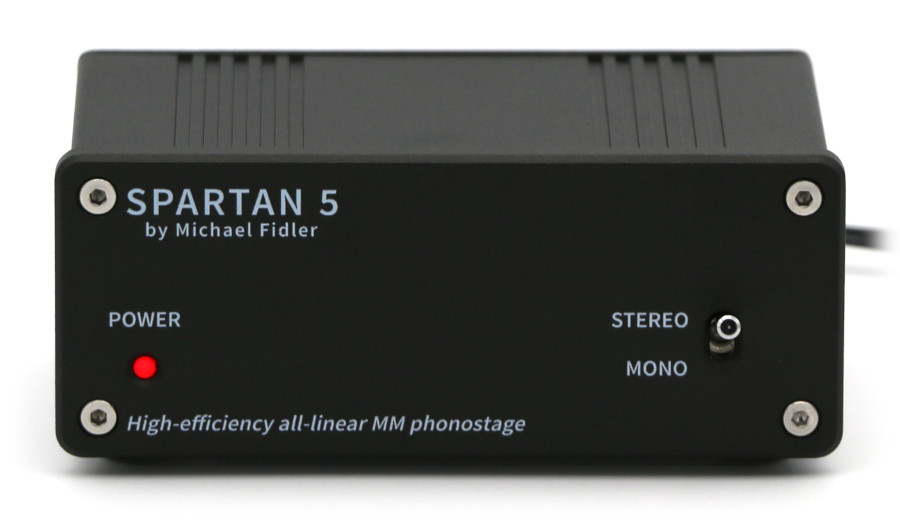
Available in black and silver case styles, the SPARTAN 5 measures 110*46*90mm
By innovatively weaving and integrating extra circuitry around a specially selected low-noise amplifier, powered by circuitry unconventional for the 21st century, the SPARTAN 5 attains the following features, often not seen even in double-stage designs:
- Strong RIAA accuracy of ±0.25dB from hand-selected film capacitors, beating contemporary phonostages that barely make ±0.5dB
- Lower distortion of less than 0.0015% through a tuned active RIAA network, carefully matched to the amplifier stage
- Low background noise from an input amplifier chosen specifically for real moving magnet cartridge impedance characteristics
- Mono switching uncovering detail by reducing noise and distortion on mono and heavily worn discs
- Second order subsonic filtering, integrated into the input network, using hand-matched capacitors to preclude tolerance issues
- Fully linear, RC smoothed, split power supply for a hash-free listening experience with less than 0.5W idle power consumption
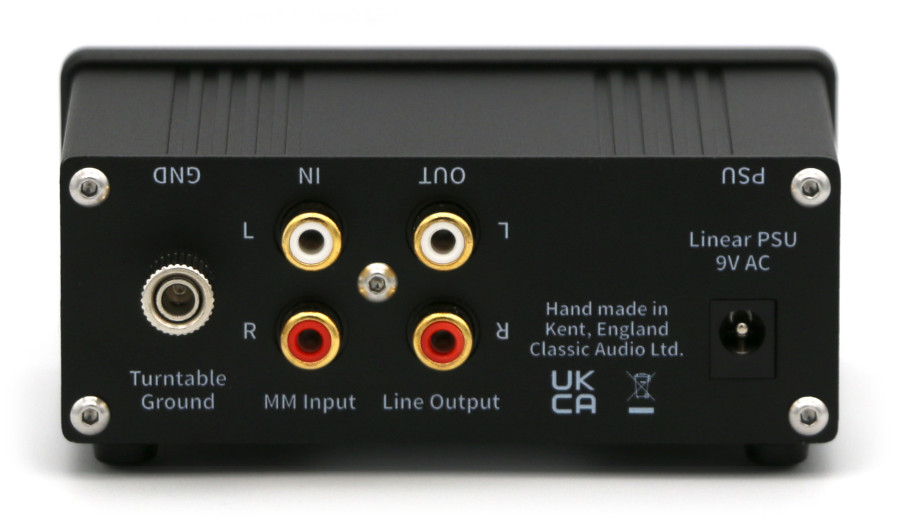
Rear panel, showing connections
These features make the SPARTAN 5 an excellent upgrade over many integrated amplifier phonostages, in addition to mass market external phonostages that offer no improvement over integrated ones. One type of setup that the SPARTAN 5 can bring the greatest improvements to is an upgrade to the low cost phono preamplifiers hidden inside many modern turntables that offer a line level output, as shown below.
Annotated comparison video from the Audiophil YouTube channel
Whether you're new to vinyl and looking for an easy upgrade over a setup like the one above, a long-time record collector looking to further improve over an integrated phonostage, or simply seeking the best practical performance from a moving magnet setup at this price, the SPARTAN 5's clarity and transparency will help you reach another level of immersion in your music.
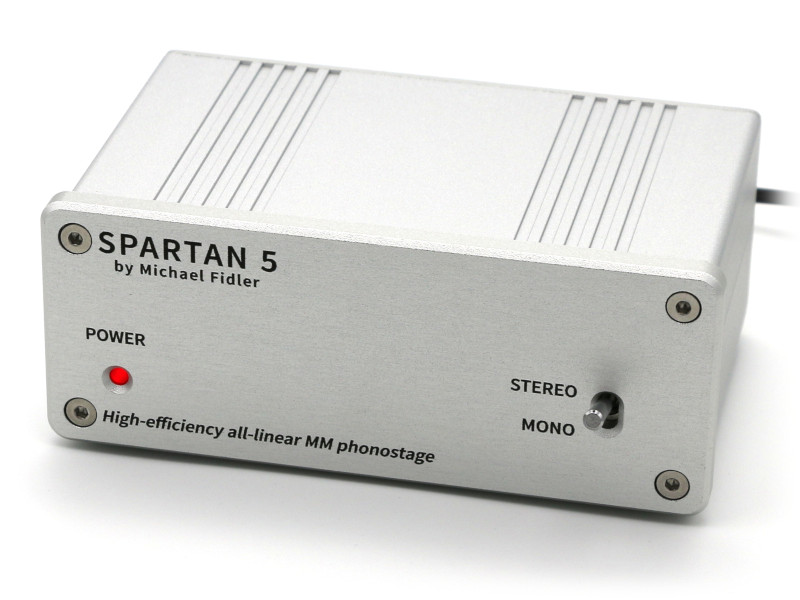
Silver SPARTAN 5
Silver and black units are now available to order in the UK and worldwide, supplied with GB 240V, EU 220V, and US/NEMA 120V PSUs to respective regions. SPARTAN 5s have now been shipped to Europe, the USA, Canada, and Australia to name a few destinations! Please see the order page for more details and prices in multiple currencies.
Build quality
Hand made in Kent, England and sitting inside a thick sandblasted anodised aluminium enclosure, the SPARTAN 5 is small in size, but full of quality components...
- All hand-soldered through hole technology, no cheap surface mount components
- Double sided, fibreglass, plated through hole PCB, with ground planes on both sides for very low cross-talk
- Film capacitors in the equalisation network and subsonic filter, distortion free NP0/C0G ceramic capcitors filter RFI on the input
- All electrolytic capacitors are long life Panasonic FR series, lasting for decades to come
- 1% tolerance metal thin film resistors in the audio path for high gain accuracy and excellent linearity
- Professional quality amplifier IC in a turned IC socket, easy to change if destroyed by faulty electronics downstream
- Gold plated toggle switch rated for 50,000 cycles instead of the usual 10,000 cycles of cheaper push switches
- Gold over nickel plated RCA connectors on the rear panel
- Nickel plated solid metal ground binding post that can accept banana plugs for easier connection
- 6mm CNC milled aluminium front panel, anodised for scratch resistance
- Stainless steel panel screws, all hex heads
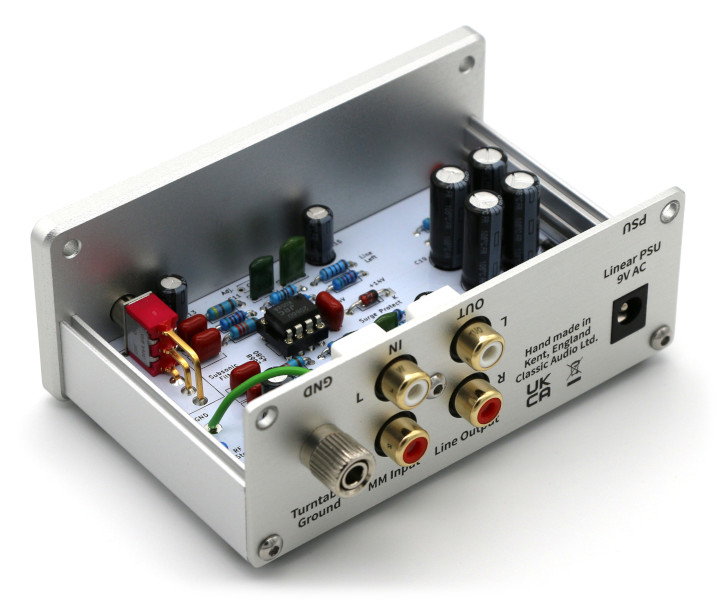
Internal and external build quality
Despite the low price of £150, build quality is up there with the best, assuring consistent performance for far longer than many high-end products. Classic Audio believes that time spent building anything using inferior components is time quite frankly wasted regardless of the financial return. Not much spare room inside? That's because unlike many commercial products Classic Audio units are built to a standard of performance, longevity, and quality, starting with the circuit design first and working back through the PCB layout to the enclosure design. The cost comes afterwards!
Specification
Classic Audio is proud to present the hard-earned specification of the SPARTAN 5 up-front, before going into greater detail regarding the highlighted features of this product. There's nothing to hide here, even though it was originally thought that it would not be possible to make a product like this based around a single amplifier. After a brief breadboarding shock on a dull January afternoon revealed that it might be possible to make a phonostage with the features listed above while maintaining excellent performance exhaustive, an exhaustive effort has gone into fettling the specification listed below:
| Parameter | Measurement |
|---|---|
| Gain at 1kHz, 10kΩ line load | 40dB, 100x |
| RIAA accuracy | ±0.25dB, 45Hz to 22kHz |
| Channel balance | ±0.25dB, 45Hz to 22kHz |
| Channel separation | 80dB, 20Hz to 22kHz |
| SNR, ref 5mV, cartridge load | 76dB, 6300x, 220Hz to 22kHz |
| Overload margin, ref 5mV | 24dB |
| Maximum input at 1kHz | 84mV RMS |
| Maximum input at 10kHz | 420mV RMS |
| Maximum output, 5kΩ line load | 8.5V RMS, 22Hz to 50kHz |
| THD, 10kΩ line load | <0.0015%, 45Hz to 22kHz, 8.5V RMS output |
| Input capacitance | 120pF |
| Input impedance | 48kΩ, ±1% |
| Output impedance | 100Ω |
| Minimum line load impedance | 5kΩ |
| Subsonic filter | 20Hz, 2nd order, -13dB at 10Hz |
| Power supply | Split linear ±14V |
| Power consumption | <0.5W |
Utilising a gain of 40dB, the SPARTAN 5 will take a nominal cartridge output of 5mV all the way up to a 500mV line-level output. Other products at this price, inevitably running off switching power supplies, often don't have the output capability to realise this without overload. They therefore feature a lower gain that causes digital sources to be much louder in comparison when switching between inputs, leading to annoying level changes when surfing between vinyl and CD collections. The SPARTAN 5 has enough in reserve to keep up with most digital sources so you're not left constantly reaching for the volume control.
The best vinyl pressings are capable of an SNR (signal-to-noise ratio) in excess of 72dB, or 4000 times, so it's important that the phonostage is able to match this level of dynamic range by having a low noise input. If not, then low-level detail that makes it out of the cartridge won't be able to get past the phonostage. By attaining an SNR of 76dB, importantly with a cartridge connected, the SPARTAN 5 won't mask those tiny details that add the final magic to the musical experience. But low noise wouldn't be very useful if it couldn't handle the upper levels of than dynamic range, so with 8.5V RMS of output on tap, from 22Hz to 50kHz, there's plenty headroom right where it's needed to handle those hot-cut pressings.
Even with all that drive into a 5kΩ line load (a reasonable worst-case scenario of two 10kΩ loads in parallel) the SPARTAN 5 is quite capable of low distortion all the way to 8.5V RMS. Fastidious design choices have kept harmonic distortion, and its more unwelcome cousin intermodulation distortion, down below 0.0015%. This ensures that there is no harsh or grainy quality to the playback that can cause listener fatigue and veil detail in more complex passages where multiple instruments are playing.
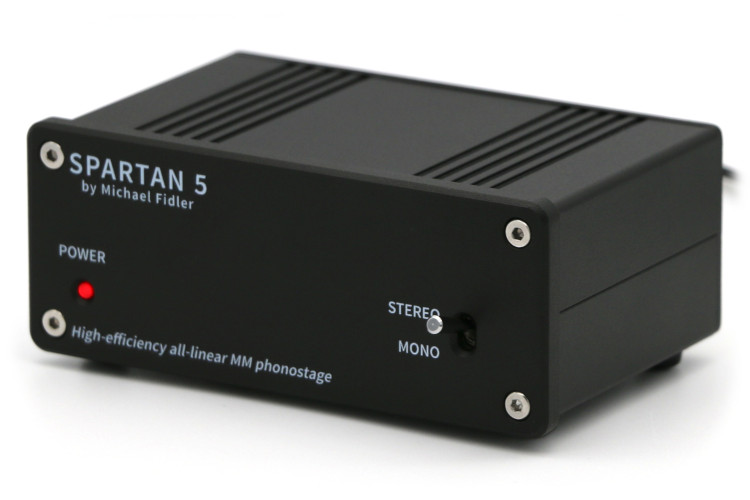
Low noise, plenty of headroom, and low distortion
Vinyl playback can produce some fairly hefty transients that cause many phonostages to overload and cloud the critical mid-range, but with a maximum input of 420mV at 10kHz, rising up to 800mV at 20kHz, right where the sharpest transients due to recorded level and surface damage will be when using a moving magnet cartridge, the SPARTAN 5 is able to handle the hardest source material without complaint. Transients and loud passages rich in high-frequency content are reproduced without overload much unlike designs that use passive RIAA equalisation that represents a heavy load on the drive amplifier and throws away headroom at the critical high frequencies.
Presenting an input impedance of 48kΩ and a load capacitance of 120pF to the cartridge (which will combine with the interconnect and tone-arm capacitance to give a total of 200pF or so), the input is well matched for virtually every HiFi MM cartridge on the market, without the need for adjustable loading. On the other end, keeping the output impedance to a low 100Ω makes for negligible insertion loss and risk of electrostatic interference when connecting to equipment downstream.
RIAA accuracy
When records are cut, they are encoded with RIAA equalisation. This matches the spectral power distribution of recorded music to the frequency characteristics and limitations of the constant-velocity cutting head and magnetic playback cartridge on your turntable. To play records back correctly, the phonostage must reverse the cutting curve to restore the balance, hence the name RIAA equalisation. Sadly, it's much harder to make an amplifier accurately adhere to a defined curve than it is to make it with a flat frequency response, so it's very often the case that the RIAA curve is either over or under compensated, colouring the sound.

The RIAA equalisation curve on playback and recording sums to flat
The inaccuracy typically occurs as a result of component tolerances around the curve's turnover points, 500Hz and 2112Hz, unfortunately right in the mid-range where hearing is the most sensitive. Looking at the specification for most phonostages, you might notice that they specify an accuracy of ±0.5dB on replay, which can result in an error of 1dB when combined. This is arguably audible when taking the frequency range into account, and seems to be the most plausible reason for perceived differences in the tonal character of phonostages. We want transparency, however, not character!
The weakest links in the RIAA network are capacitor tolerances. In order to attain better RIAA accuracy, more precisely manufactured capacitors have to be used, but can get expensive quite quickly. The SPARTAN 5 takes a different approach to reduce colouration, and instead utilises classic 'greencap' 100V film capacitors, distortion free up to 10V RMS and found in some of the most revered vintage equipment. These are then hand-chosen to a much stricter tolerance than the conventional 5%, to perform the task of faithfully inverting the RIAA curve on playback. This doubles the accuracy compared to other offerings from ±0.5db to ±0.25dB, resulting half the colouration of the sound and a much truer listening experience.
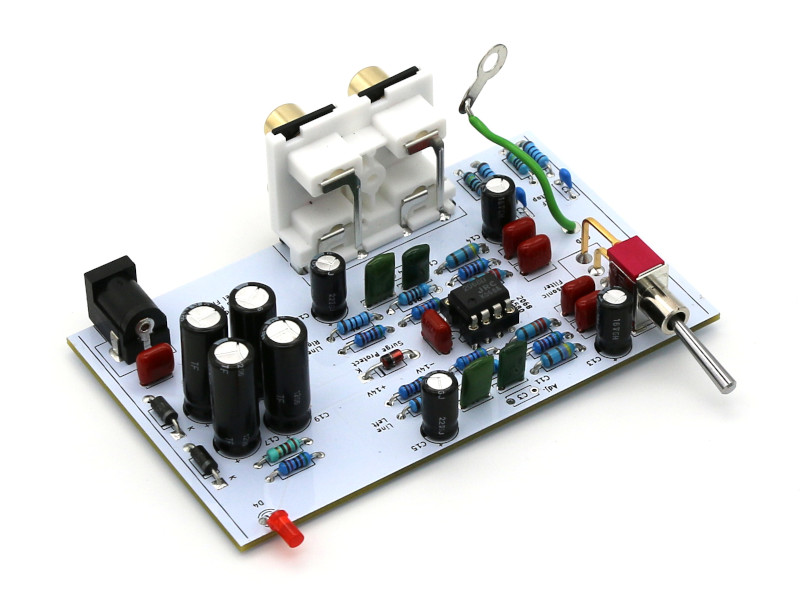
Hand-selected green epoxy-dipped RIAA film capacitors
It is amusing to consider the strong aversion exhibited by the proponents of phonostages featuring severe RIAA infidelities, to certain types of tone controls that exhibit similar inaccuracies due to potentiometer tracking issues. While the difference in sound may be perceived as a benefit on initial listening, colouring the frequency response probably isn't the best thing to do if we are searching for a transparent, high fidelity, listening experience. Characteristics that sound exciting at first often become fatiguing after a short period of listening.
Subsonic filter
In descending order of severity surface imperfections, bearing noise from the turntable, tone-arm resonances, and defects in the lathe that cut the original master all contribute some subsonic disturbances and noise below 20Hz. This insidious interference, inaudible on its own, causes issues in many amplifiers, but mainly in loudspeakers and headphones by causing the driver to wobble and modulate the audible recorded sound due to non-linearities associated with excursion. It often causes over-excursion far before maximum level would otherwise be reached, robbing the system of headroom, generating an unpleasant and fatiguing shimmering effect that can be hard to pin down, and in its most benign form manifesting as an unstable stereo image. Just a few millimetres can be enough to ruin the experience.
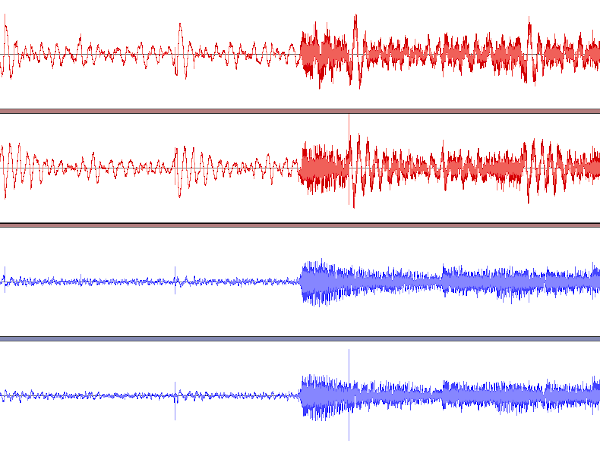
Havoc-inducing unfiltered (red) and filtered (blue) waveforms of a 45RPM EP
The waveform above shows how subsonic content on the record's surface can easily exceed the recorded level in some cases, even on a high-quality setup. Less scrupulous manufacturers will try and pin the blame on the customer, simply claiming that they're having issues with the tonearm and cartridge combination, instructing customers to 'live with it'. Classic Audio recognises that the record itself is the cause of the problem. An effective subsonic filter is required. It's necessary reduce low frequency disturbances, at their worst around 10Hz, by at least a factor of four (12dB) to preserve the performance of the system as a whole. Luckily that's exactly what the SPARTAN 5 manages...
Usually a double-stage design is mandated to implement a filter capable of reducing subsonic disturbances to an acceptably low level, but the SPARTAN 5 works around this by innovatively implementing a maximally-flat second order filter as input network. The positive feedback required to implement a Butterworth filter is tapped out of and tuned into the RIAA network for a very elegant circuit indeed. By blocking the subsonic content in the input coupling network before the it reaches the amplifier stage, subsonic disturbances are prevented from eating into the final headroom of the phonostage. Most double-stage designs aren't even capable of this because all the gain is applied on the front-end, although the SPARTAN 10 is a notable exception due the the distributed gain structure.
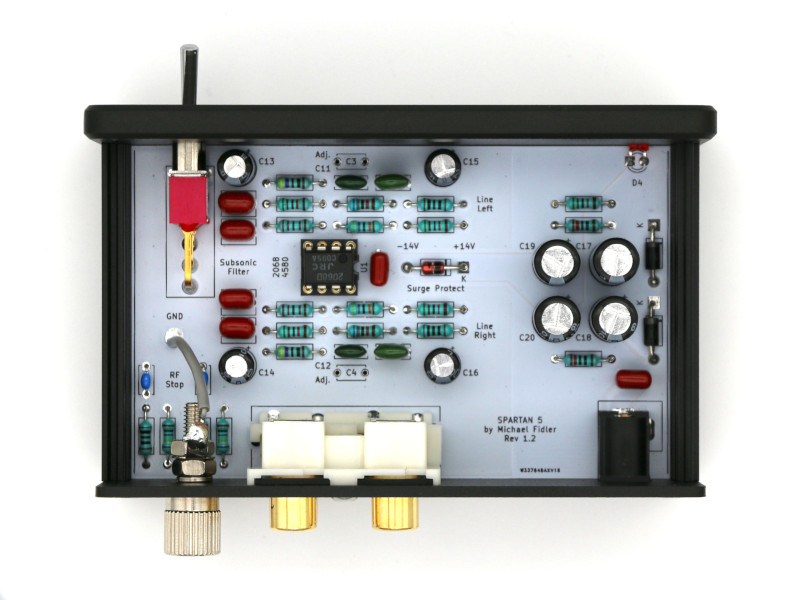
Subsonic filters on the input side using red epoxy dipped film capacitors
As can be seen in the image above, the subsonic filter is implemented on the input side of the PCB layout, right after the RF filter (bottom left), which stops radio frequency interference from cellphones etc. from interrupting musical enjoyment. The subsonic filtering capacitors, well-regarded polypropylene film 'red drop' types, are also hand-matched to 1% each other for each SPARTAN 5, ensuring that the frequency response above 20Hz stays as flat as possible for uncoloured bass. This also ensures that superb matching between the left and right channels is held right down to the lower end of the spectrum. To the knowledge of Classic Audio Ltd., the SPARTAN 5 is the first commercial phonostage to implement this input filter circuit, although submissions to the contrary are most welcome!
The subsonic filter also blocks the input bias currents from the bipolar amplifier from getting into the cartridge without any extra DC decoupling components in the signal path. You can therefore hot-swap headshells without any clicks, thumps, or bangs disconcertingly emanating from the loudspeakers in your system. Very handy if you have a lot of discs in 'previously enjoyed' condition that play better with a conical tip in mono mode...
Mono switch
If the best results are going to be had from mono discs, then a switch that puts the phonostage into mono mode is a must. When switching to mono, all stereo information is cancelled, which on a mono only disc will consist only of extra noise and distortion, the latter being particularly unpleasant as it sits quite distractingly across the stereo field. The mono switch may also be effectively employed on very worn or distorted stereo pressings, reducing distortion and surface noise enough to make otherwise unlistenable discs enjoyable again.
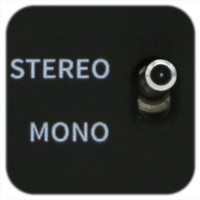
Distortion cancelling mono switch
One of the handiest functions of the mono switch is the ability to instantly cancel out the jarring effects of 'stereo reprocessed', or 'simulated stereo' re-releases of mono recordings. These pressings can be picked up today for modest prices, mainly because the use of reverb and phase effects across the channels are fatiguing and not pleasant for modern listeners, who rightly see no novelty in stereo sound effects. Switching to mono undoes all the processing effects that exist in the stereo difference, allowing for enjoyment of the original mono source once again in almost all cases. Customers have been surprised at the night-and-day difference this has brought about on many of these discs, uncovering new detail under the clanging reverb effects.
I pulled out a reader’s digest box set entitled ‘112 rock n’ roll greats’. This is quite comprehensive compilation of early rock n’ roll recordings. The eight LPs in the set are in stereo, though many of the recordings themselves are mono. The copy I have has a nasty tick in the left channel most of the way through the first side which happens to contain exclusively mono recordings, so I set the Spartan to mono, threw on some headphones and cued up.
I now realise what I’ve been missing. The vinyl roar at either extreme of the stereo field draws the mind to itself, detracting from the monaural image. Take that away, and the result is an incredibly clean recording that has great vertical depth. For a mass-market compilation these are excellent pressings; very dynamic and without too much music crammed onto each side of the discs. As a consequence the perforce has bags of low-end slam and great top-end detail. So much so that the distortion in the old microphones is quite obvious, and easily distinguished from any artefacts of the record itself. I am a convert – it turns out a mono switch is in fact the best way to hear a mono recording. And the tick? It blends seamlessly and practically disappears, only audible between tracks and even then not in a way that is jarring or distracting.
Ashley Cox - Audio Appraisal
The mono switch, combined with the SPARTAN 5's subsonic filtering and excellent high frequency headroom, also allows for the satisfactory playback of a great many 78 RPM discs; American cuts from the mid 1930s onwards that typically equalise to within a couple of decibels or less with the modern RIAA curve. All 78s from 1955 onwards use the RIAA curve so can be played back through the SPARTAN 5 with the correct stylus on a swap-able head shell, made even easier by the thump free full input decoupling.
Linear PSU
Many small phonostages today use an external switching power supply that can inject nasty audio frequency currents straight from the mains into the audio ground path between the phonostage and power amplifier, resulting in unpleasant buzzes, hums, and whines. In most cases this adds a most unwelcome accompaniment to the music. Switchers also have a very undesirable habit of allowing the ground to 'float' at 80V RMS or so, more than enough to damage sensitive line inputs when hot swapping equipment.
The ubiquitous 24V DC switching supply used for cheap equipment, allows a maximum output of only 7V RMS vs the SPARTAN 5's minimum of 8.5. This increases the risk of obtrusive overload when attacked with signal levels from hot singles (of the 7 and 12 inch variety - stop laughing!) and surface scratches. They are notoriously unreliable, due to the proximity of low cost electronics and heat.
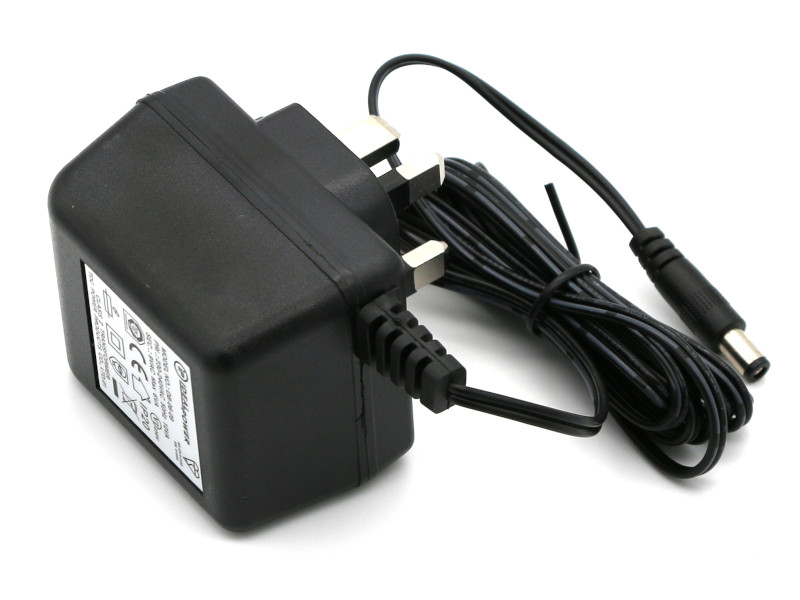
Linear transformer power supply used with the SPARTAN 5
By using an external linear transformer based power supply, the SPARTAN 5 keeps the power transformer and its troublesome magnetic field and mains voltage where they belong; well outside the enclosure. As the external PSU is double insulated, the risk of ground loops between the amplifier and SPARTAN 5's PSU is also entirely removed. External transformer based power supplies, while not as cheap or convenient as switching ones for a low parts count and corresponding low cost, have an excellent track record for longevity and are easily replaced in the highly unlikely event of failure.
The internal power supply circuit also features a split rail arrangement, meaning that the power currents drawn by the amplifier never flow into the sensitive circuit ground. Instead they flow from the positive voltage rail to the negative one. In an inferior single supply arrangement, the negative voltage is almost always the signal ground, unless the circuit is 'upside-down' in which case it is the positive rail. This poses a real issue as op-amp power currents are almost always heavily distorted versions of the signal they are amplifying. Keeping them out of the ground means they can't cause a differential voltage in the signal path and work there way onto the output, degrading the distortion performance of the circuitry.
No off switch?
That's right, there's not an off switch in sight. Classic Audio isn't trying to cut costs by making the customer pay for in energy what should have been included in the parts cost, though. That's because the SPARTAN 5 is so power efficient that it simply doesn't need one. Even if there was the inclination, there's no need to resort to making highly dubious, and conveniently unfalsifiable, claims about 'burn in' to justify this. With the ultra-high reliability components contained within and the high efficiency of the single amplifier stage, it simply doesn't make sense to add one!
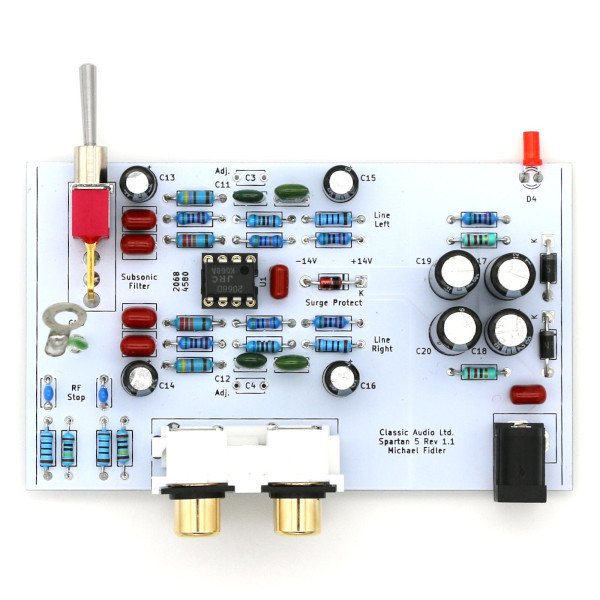
PCB layout showing split RC smoothed supply (right)
Instead of conventional voltage regulation to combat power supply rail hum, the SPARTAN 5 takes a old-school approach with RC smoothing, pulling voltage rail hum and noise down to the same levels as conventional regulation when loaded with just the single amplifier stage. As there are no regulators consuming idle power, current only flows through the amplifier stage, already very efficient at 180mW, and the power LED string at 15mW. Consequently, the total power consumption is kept under 0.5W, negating the need for an on switch and power-consuming startup mute circuitry.
Set your mind at rest that if left plugged into a UK wall socket, with our extortionate energy prices potentially rising to 50p/kWhr, the SPARTAN 5 will set the customer back no more than £2.20 each year in energy costs.
Reviews
Audio Appraisal's notorious man of no-nonsense, Ashley Cox recently gave the SPARTAN 5 an excellent review...

The Spartan 5 is a diminutive little box, in which is a simple but objectively and subjectively top-class circuit typology designed by a man who clearly knows his stuff where the humble vinyl and its playback transducer are concerned.
If the Spartan 5 demonstrates what he can achieve on a budget, I very much look forward to seeing what he comes up with next. The Spartan 5, £150 is available now from Classic Audio Ltd. If you’ve been eyeing up another model, even one that is considerably more expensive, the Spartan series should be underlined at the top of your shortlist. They represent high-end objective performance and save you a boatload of cash. Highly recommended.
Ashley Cox, Audio Appraisal
The SPARTAN 5 has also been positively reviewed by Sound Perfection Reviews, alongside the MM PRO.

Hooking up the Spartan 5 for the first time I was not sure what to expect to be honest, and after a few days of getting used to it I decided to sit down and evaluate the differences between it and the Phono box. Without sounding too cliché, it was a real ear-opening experience for me, even my partner was shocked at how much of a difference this little pre-amp made. The Spartan 5 is a very clean, clear and detailed pre-amp, it masks nothing and comes across as neutral sounding without any emphasis on any part of the audible spectrum.
The Spartan 5 is a steal at its current £150 price point, you get a linear and detailed sound with a well implemented subsonic filter and linear power supply. This is likely to be all the pre-amp most listeners will need when using a system like mine.
Oscar Stewart, Sound Perfection Reviews
Customer reviews
Feedback from customers all around the world has been very positive...
Just wanted to write and say I got the Spartan 5 on 21 April, and have been really enjoying it - loving the sound from my vinyls!
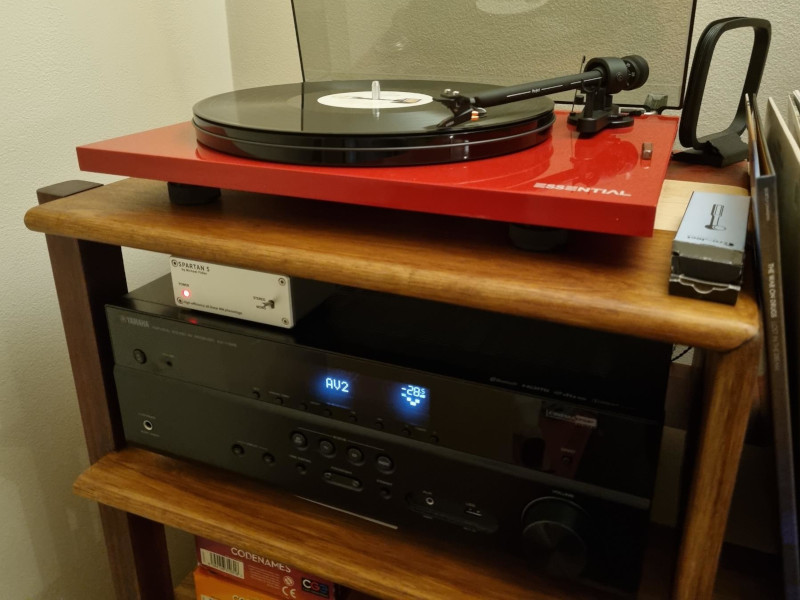
SPARTAN 5 in Patrick's setup
For a relatively low-budget music lover starting out with a hi-fi set up, the Spartan-5 has been a fantastic addition to my set up. I hear instrumentation and nuance that I didn't before, and more clarity overall.
Patrick, Australia
Chris decided to try a SPARTAN 5 in January 2023 and got in touch with his feedback:
My initial impressions of Michael Fidler's Classic Audio Spartan 5. No LF crossfeed in this version, but you do still get the all-important mono switch. Michael has written a very good explanation of why this is a good idea when playing mono records.
I've tried it in two configurations of my "upstairs" setup. A note of caution - the source in both cases is a Garrard Synchrolab idler drive (K9 cartridge and VM95ML stylus) so any low frequency differences are going to be hidden by rumble! But other than that it's not a bad TT. Yes, I know I'm insane. A Planar 2 would be quieter, but I like it.
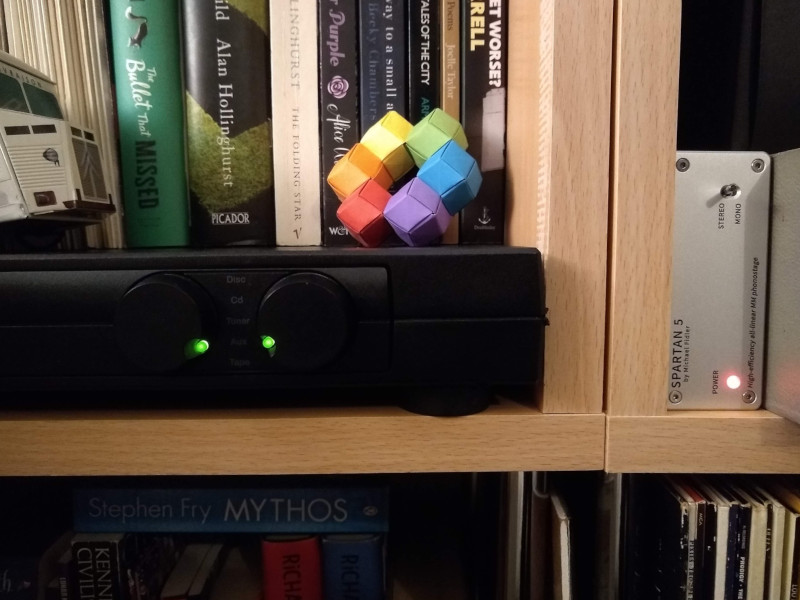
SPARTAN 5 in Chris's setup
Setup one was with a very elderly Naim NAC 32 (plus homebrew PSU) and an NAP 90, comparing against the NA322 boards in the 32. Using the Spartan instead gave a slight increase in high frequency detail. Not huge but worthwhile. I lack the test equipment to be objective about this, but bearing in mind this design uses a single op-amp, it's a remarkable achievement as the NA322 imo is a good phono stage. But the best is yet to come ...
Config 2 is with a Rega Brio (original clamshell version). Unsurprisingly the Spartan beats the Brio's internal phono stage hands down, with loads more HF detail and better imaging. I reckon a fair bit of that is having a power supply which is unaffected by whatever the Brio's PA stage is doing. It's cleaner, more detailed, but doesn't remove the Brio's verve. Here's the best bit: the Brio plus Spartan is right in contention when trialled against the 32/90 - in fact, after a day's listening, the Spartan/Brio combo is my preferred setup of the two. The Brio is a vivacious but not overly accurate amplifier, and with the Spartan you still get the boogie factor but with more information.
So, if you're after an external phono stage to improve on an integrated one, it's definitely one to put on your shortlist. I listen to a lot of old stuff so the mono switch yields benefits - really worth having if your amp doesn't have one. The reduction in vinyl roar (OK yes and rumble!) is considerable, and it's nice not to have pops and clicks flying all over the soundstage while the music sits in the middle.
Chris Cox, Worcester
Neil bought the first SPARTAN 5 production unit. After a week of listening this is what he found:
As promised, a short review of the Classic Audio Spartan 5 single-stage phono preamplifier.
My system: AT LP5x with VM95 in RigB housing with basic VMN95E stylus. Spartan 5 into a Marantz PM5005 amp’ driving a pair of bookshelf DALI Spektor 1. Basic interconnects. I contacted Michael Fidler in June to enquire about the Spartan 10. At £350 it was over my budget and disproportionate to the rest of my system. He did however put me on the waiting list for the more frugally priced Spartan 5 which was in development and became available at the end of August. Mine arrived on September 1st.
The build quality of this tiny unit is excellent, as is its presentation in a smart silver case with a brushed finished fascia plate secured by hex head screws. As you can see in the photo, it sits on my Topping DAC with no unsightly overhang.
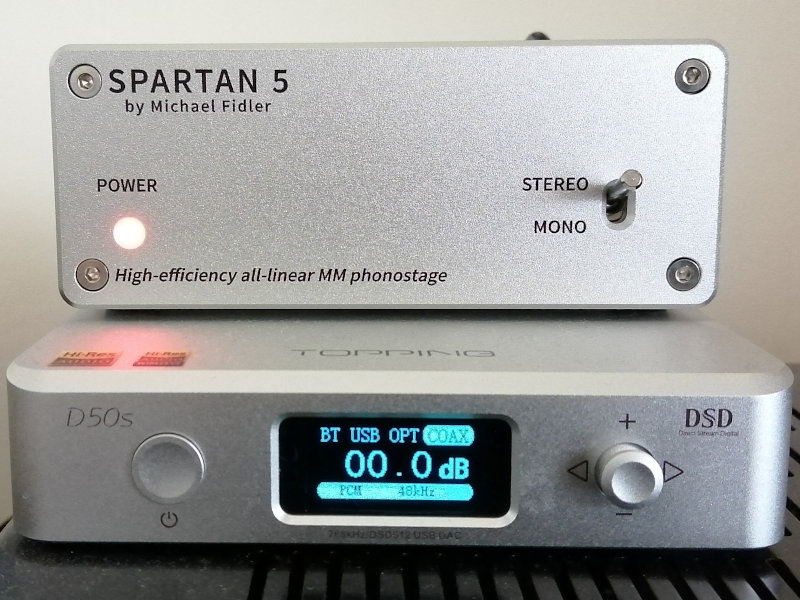
SPARTAN 5 in Neil's setup
Now I’m not blessed with *les oreilles d’ors*, but I have retained good hearing in both ears despite my being 53 years old and an ex-clay shooter. I can still pick up 14.2 kHz with both lugholes. These are my findings thus far:
For starters, much more detail is discernible from the pressing. Me and a mate listened to Head Over Heels from TFF’s Songs From the Big Chair and heard percussive sounds that we hadn’t heard before. And we’ve been listening to this masterpiece since 1986 on CD and vinyl.
I’m trying not to sound pretentious which is always difficult when laying down personal perceptions of something so subjective as sound reproduction. But this is how I heard it so here goes. On the y axis, the Spartan 5 stratifies and therefore separates the voices and instruments into an amplitude-based priority. Simultaneously, it images superbly in the x and z planes for an exquisite soundstage. Although this last comment applies more to when using speakers than my modest Fildelio XH2HRs. Genre-wise, I’ve put Joy Division’s Unknown Pleasures, Sibelius’ No.s 3 & 7 (Rattle / Bham S.O.) and Further Definitions by Benny Carter and his superb orchestra. My comments about detail, stratification and soundstage apply to all.
As I type, the sax’ intro of TFF’s The Working Hour is playing and making my hairs stand on end.
This tiny device has greatly improved my vinyl listening experience so far. I’ve only had it a week or so and already I’m VERY impressed. I’m not affiliated with Michael Fidler and Classic Audio UK but would urge those on a budget who are looking to enhance the vinyl aspect of their set-up to seriously consider this big / little box of tricks.
Neil Bedforth, Audioshite!™ Facebook page
More customer reviews are available on the testimonials page.

